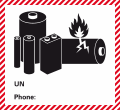ADR labels of danger
Also used by International Maritime Code for Dangerous Goods (IMDG) for overseas shipping by UN-IMO, International Maritime Organization (IMDG-Code Archived 2009-07-07 at the Portuguese Web Archive, imo.org).}}
Aussi utilisé par l'(en)International Maritime Code for Dangerous Goods (IMDG) ((traduction fr) Code maritime international pour le transport de matières dangereuses) pour les transports maritimes "gérés selon" (?) par UN-IMO, (en)International Maritime Organization ((traduction fr) Organisation maritime internationale) (IMDG-Code Archived 2009-07-07 at the Portuguese Web Archive, imo.org).
Labels provided by ADR 2007
[edit]Class 1 - Explosive substances and articles containing explosives
[edit]-
Class 1 - Explosive Dangerous Goods: Explosive substances and articles used to produce explosions or pyrotechnic effect
-
Class 1.1 - Explosives with a mass explosion hazard
-
Class 1.2 - Explosives with a severe projection hazard
-
Class 1.3 - Explosives with a fire, blast or projection hazard but not a mass explosion hazard
-
Class 1.4 - Explosives with a minor fire or projection hazard
-
Class 1.5 - An insensitive substance with a mass explosion hazard
-
Class 1.6 - Extremely insensitive articles
Class 2 - Gases
[edit]Class 3 - Flammable liquids
[edit]-
Class 3 - Flammable liquid[a]
Class 4 - Flammable solids
[edit]-
Class 4.1 - Solid Flammable material
-
Class 4.2 - Spontaneously combustible material
-
Class 4.3 - Combustible solids when in contact with water[a]
Class 5 - Oxidizers
[edit]-
Class 5.1 - Oxidizing agent
-
Class 5.2 - Organic peroxide[a]
Class 6 - Toxic and infectious substances
[edit]-
Class 6.1 - Toxic substances
-
Class 6.2 - Infectious substances
Class 7 - Radioactive
[edit]Class 7 - Radioactive components
-
Class 7 - Extremely low level radiation - Category I-WHITE (Symbol 7A)
-
Class 7 - Low level radiation - Category II-YELLOW (Symbol 7B)
-
Class 7 - Higher level radiation - Category III-YELLOW (Symbol 7C)
-
Class 7 - Contains fissile materials (Symbol 7E)
Class 8 - Corrosives
[edit]-
Class 8 - Corrosive materials
Class 9 - Miscellaneous dangerous goods
[edit]-
Class 9 - Miscellaneous dangerous cargos
-
Class 9A - Contains Lithium Ion Batteries
Other markings
[edit]-
Indicating material at an elevated temperature [b]
-
An ADR orange plate with a hazard identification number (Top) and an UN number (Bottom).
-
An orange ADR panel for display on the front and rear of road vehicles carrying dangerous goods.
-
Orientation arrows[c]
-
Packaging label for lithium cells
-
Environmental polluting material.
Limited Quantities
[edit]Dangerous goods packaged in small quantities (such as for retail distribution) and pose less risk than larger or bulk shipments.
-
Surface transport (Sea, road, rail)
-
Air transport
Obsolete markings
[edit]-
Class 6.1b - Substances that are harmful to humans/animals and must be kept separate from food/feed. Phased out early 2000s and is now classified as Class 6.1, packing Group III.
-
Class 5.2 - Organic Peroxides - Replaced in 2007.
See also
[edit]- United States hazmat markings - Dangerous goods markings in the United States
- Dangerous goods
- Category:Safety labels
- Category:Hazard symbols
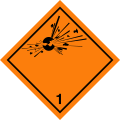






![Class 2.1 - Flammable gas[a]](https://upload.wikimedia.org/wikipedia/commons/thumb/4/41/ADR_2.1.svg/119px-ADR_2.1.svg.png)
![Class 2.2 - Non-flammable, non-toxic gas[a]](https://upload.wikimedia.org/wikipedia/commons/thumb/e/ec/ADR_2.2.svg/120px-ADR_2.2.svg.png)
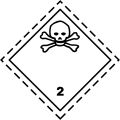
![Class 3 - Flammable liquid[a]](https://upload.wikimedia.org/wikipedia/commons/thumb/9/94/ADR_3.svg/120px-ADR_3.svg.png)
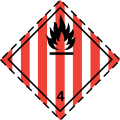

![Class 4.3 - Combustible solids when in contact with water[a]](https://upload.wikimedia.org/wikipedia/commons/thumb/9/96/ADR_4.3.svg/120px-ADR_4.3.svg.png)

![Class 5.2 - Organic peroxide[a]](https://upload.wikimedia.org/wikipedia/commons/thumb/1/1b/UN_transport_pictogram_-_5.2_%28black%29.svg/120px-UN_transport_pictogram_-_5.2_%28black%29.svg.png)
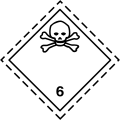
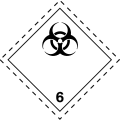


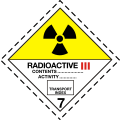

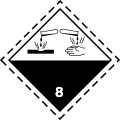


![Indicating material at an elevated temperature [b]](https://upload.wikimedia.org/wikipedia/commons/thumb/6/61/ADR_hot.svg/120px-ADR_hot.svg.png)


![Orientation arrows[c]](https://upload.wikimedia.org/wikipedia/commons/thumb/a/a3/ADR_orientation.svg/92px-ADR_orientation.svg.png)
